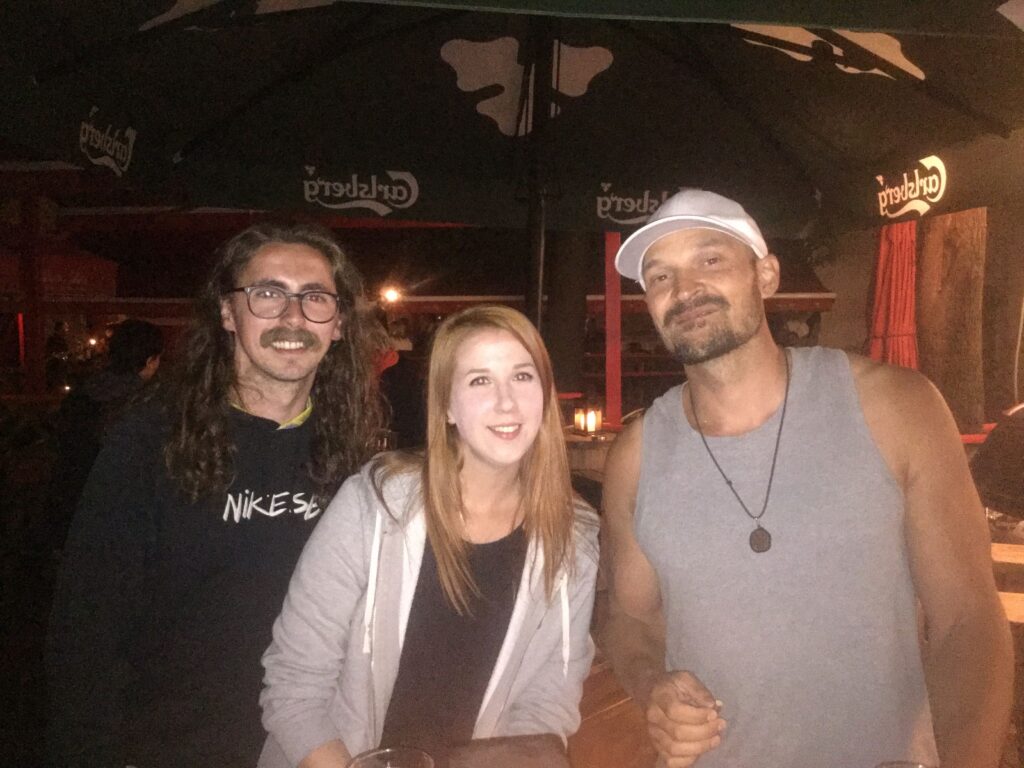Before bed, I noticed I had a little sore throat so I went to a convenience store to get some cherry flavored vodka to make myself a double hot toddy. I took a shower and when I returned, my new Russian roommate, a bald, bulky, and scary-looking dude invited me to join the conversation that he and my other female Chinese roommate were having. In his broken, but pretty good English, he asked me a lot of questions about America. The most interesting one was what would happen if a white person calls a black person the N-word. I told him depending on where that white person was, he could expect an ass-kicking. He got the point. After a Ukrainian dude showed up and we then all settled in to go to sleep.
I woke up at 5 AM and couldn’t go back to bed. After rolling around for a while, I got up and found my way to my bus stop for leaving Warsaw. As my ride was later in the day, I then headed back, made some tea, and tried charging my devices for the ride. My Russian friend was up, so we chatted a little while I had my tea. Apparently, he was in Poland to train to be a truck driver. I noticed his forearm tattoo, the German words Blut und Ehre. I knew what this was. These words, even written in the same font, were on the knives the Hitler Youth carried and translated to Blood and Honor. He noticed me looking at it and told me these tattoos were to honor his grandfather that fought with the SS in Ukraine. He had too much of a jocular tone for my liking. I looked at my watch and realized it was time to go. The Russian got up, shook my hand while deeply looking into my eyes, and told me he wished for me to make a lot of money. I am not certain if this was a typical Russian send off but I told him the same. I then gathered my things and headed to my bus stop outside of the Palace of Science and Culture.
This was not a station but rather just a bus stop on the street. I was early as usual and a line started forming. Right on time, a beautiful, large coach pulled up. The other travelers and I made our way on and found our seats. My seatmate was a Lithuanian but we pretty much kept to ourselves. I looked out the window listening to music and podcasts although there was a seatback movie display. Every now and then I would make my way to the supplied coffee machine and make myself some tea. It was an incredibly peaceful and comfortable ride through the vastness of the Polish countryside was equally matched with the vastness of the Lithuanian forests.

When we reached the outskirts of Vilnius, I noticed something very interesting and somehow familiar. It was a nuclear power station of the typical Soviet-style. I would come to find out later why it was so familiar.

After one stop, we were dropped off at the Vilnius bus station. It was a little difficult to get my bearings, but I was able to find my way through the Gates of the Dawn, the entrance to Old Town and made it to my hostel. I met the owner, a gentleman named Dean from Manchester, England who was incredibly affable. I could tell he loved Vilnius when he told me about everything I could do in the city. I knew I would like it here.
I dropped my stuff and headed to a grocery store off a little square. To my chagrin, the supermarket wrapped their alcohol section off in crime tape as it was illegal to purchase it on the weekends for some reason. I got my dinner, headed back to the hostel, and started cooking. Suddenly, a team of British guys came in and wanted to play drinking games, so I cleared out. They offered me a shot of Vodka and invited me to come play with them. I thanked them for the invitation but regrettably declined as I was very tired. When I came back to my room, there was an Aussie couple (Bree and Josh) that were doing a walkabout after the young lady renounced her job in London before they headed home. They seemed very nice. And while I wanted to stay up to chat, I needed to go to sleep.
The next morning, I got up, walked through the downward sloping Old Town on my way to a former prison of the Lithuanian contingent of the Komitet Gosudarstvennoy Bezopasnosti, otherwise known as the KGB. It was pretty far away on foot, about 2 kilometers, but it was an incredibly scenic walk through Vilnius. Taking a left at the Vilnius Cathedral, I walked up a long thoroughfare and arrived. I bought my ticket, rented and an audio guide, and began my journey.
The prison was first built in 1899 during the rule of the Czar of Russia for dissidents as Lithuania was under their control at the time. When World War I was being fought, it then became German-occupied. By 1919, it was a Bolshevik center. By 1920, Poland then occupied Lithuania and it became a courthouse. In 1940, the Baltics were swallowed up by the Soviets and this building became the headquarters for the early incantation of the KGB, the NKVD. When the Nazis advanced on the Baltics, it became the Gestapo Headquarters. When they were eventually ousted by the Red Army, this building reverted back to the Soviets and was turned into a KGB detention, torture, and execution center until 1991 when the Soviet Union dissolved.

Being a historian for this particular era, I could tell I was really going to get a lot out of the museum. The cells were located in the basement, obviously enough and given the state of affairs, many, many people were housed in very small rooms. These were the regular cells. The initial cells, where individual inmates were held for processing were smaller than a telephone booth. I walked in one, while some German guy followed me in and shut the door. Needless to say, the WTF look on my face caused him to open it again and hurriedly and make his way down the corridor.
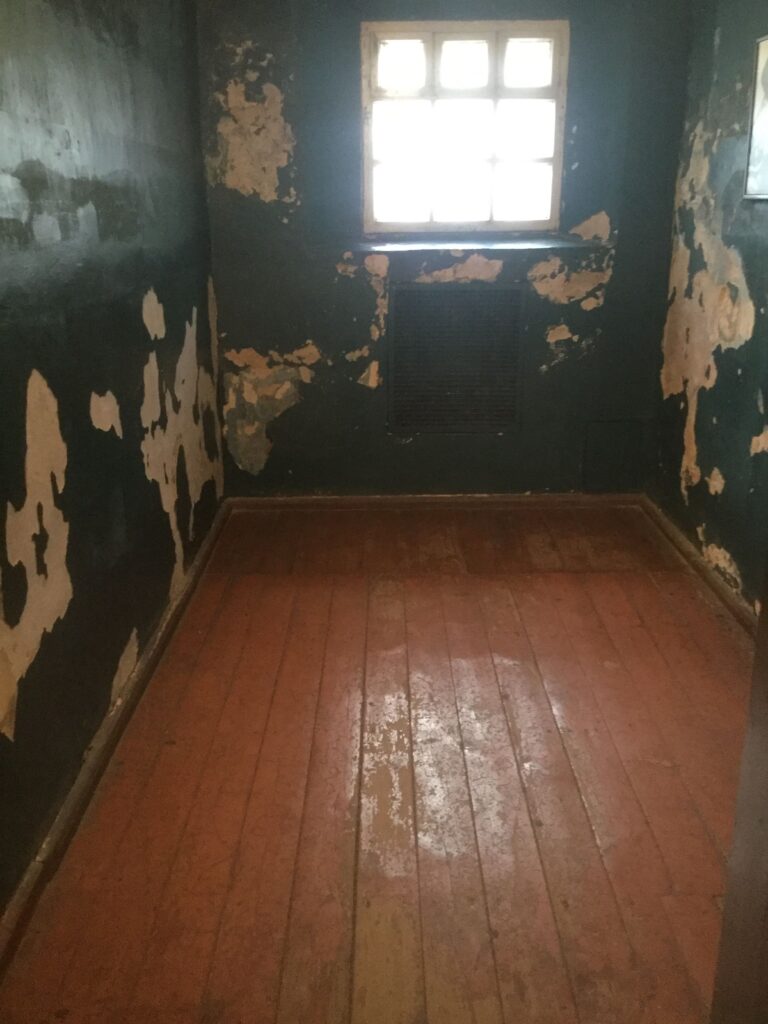
The special cells were located deeper in this hell on Earth. There was a padded cell for people that had gone mad from torture, complete with a straight jacket stretched out from wall to wall like some sort of demonic wings. Further down, was the ice room. Given the geographic location of Lithuania, it gets very cold. What this KGB-designed cell had was a floor like a wedge with a metal plate in the center. The idea was to flood the room with water, so it would turn to ice, leaving the cold metal plate as the only place to stand in the cell. For added torture, they stripped the prisoner of their shoes. It was only a matter of time before things started falling off due to frostbite.

Passing the exercise yard, the tour continued to the execution chamber. The process would go like this: The accused would be read their crimes against the State. They usually professed their innocence that would fall of deaf ears. They would then be grabbed by the arms and marched into the next room. As they were walked in, there would be someone waiting behind the next door and would simply put a gun to the back of their head and pull the trigger. The last thing the accused would see is a concrete wall with boards coving it to keep down the chances of a ricochet down. Then, the captors would open a panel, place the corpse on a chute to land on an open truck bed where the body was then taken to a mass grave. They would then squeegee the leftover blood and brain matter into a drain on the pitched floor after hosing it down to get it ready for the next enemy of the state. This happened every day, multiple times per day, at all hours of the day. If you want close proximity to what this was like, I would suggest watching the very wel done Polish film Katyn.

Out of the basement, the rest of the museum focused on Lithuania before, during, and after the wars. Like the other countries in this part of the world, they had many types of governments in a short period of time. When the Nazis took over, they liquidated 95% of the Jewish population. However, it was also clergy members that were persecuted by the Nazis as well as the Soviets. Something else I learned is that Lithuania still has practicing members of a faith called Romuva. It is a pre-Christian pagan belief system that incorporates ancestor worship as well as nature. They were also persecuted by the Nazis and Soviets.
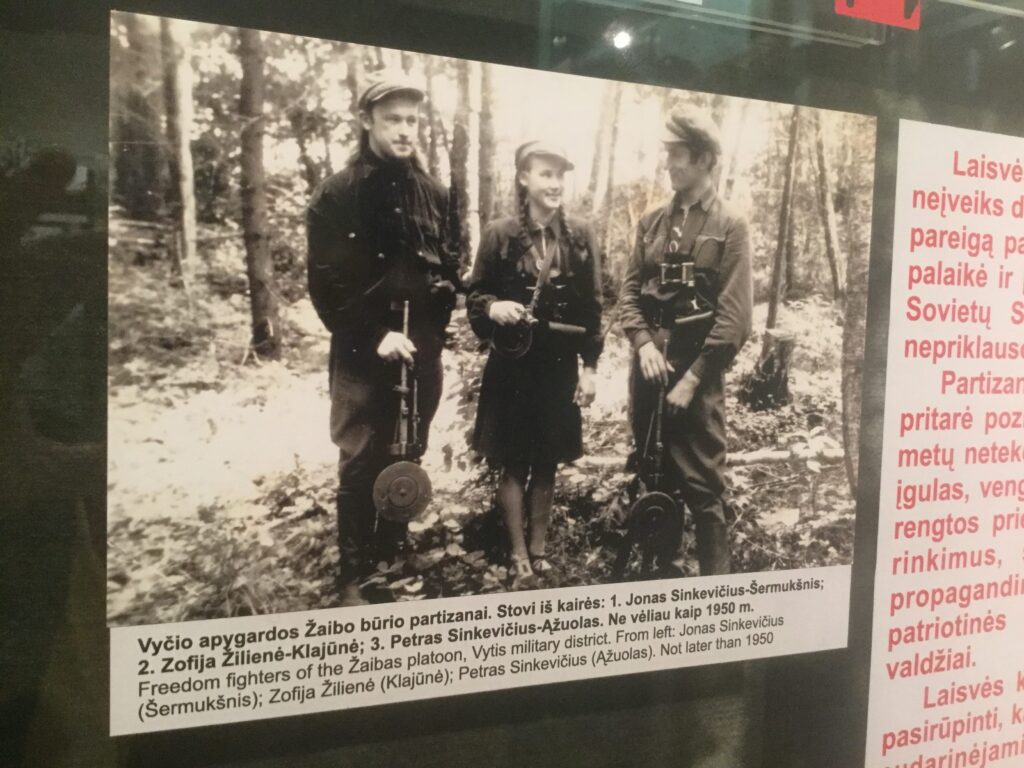
One of the aspects that I really liked about this museum was the emphasis that they had on the “Forest Brothers.” These were the Baltic Partisans that tormented both the Nazis and the Soviets. They took oaths not to drink, had some uniforms, some just armbands, lived in the woods in elaborate bunkers, welcomed women into their ranks, and fought like hell. What I liked is that this museum showed both what these people were fighting as well as what happened to them if they were caught. However, the best part was their patriotic songs. I do not speak Lithuanian, but I could tell the emotion and comradery in their lyrics.


Further upstairs, the museum discussed life in Communist Lithuania including the methods of bugging that the KGB used to keep tabs on people. There was even a photo lab where they not only printed pictures but manipulated them. People did not like living in this police state, so as Soviet rule started to thaw, people like Vietnamese monks self-immolated in protest.
The final exhibit was about a movement that had people from all the Baltic countries join hands in protest. There were 2 million people (of countries with a total population at the time of 5.4 million) that participated in the Baltic Way on August 23rd, 1989. This date was significant because it was the 50th anniversary of the Molotov-Ribbentrop Pact, or the Nazi-Soviet Non-Aggression pact which basically stated that the Nazis could consolidate land would not invade any territory that the Soviets also consolidated, which included Lithuania. A few days later, Germany invaded Poland thus starting World War II. On the 22nd of August 1989, the Supreme Soviet commission of the Lithuanian SSR declared that the Soviet occupation in 1940 was illegal because it was based on the Molotov-Ribbentrop Pact. After that, people held hands along roadways from Vilnius, through Riga, Latvia, all the way to Tallinn, Estonia. This was one of the largest peaceful protests ever.
After spending 6 hours in this beautiful and highly recommended museum, I needed to find somewhere to eat. Luckily, a friend from college was a food writer and after consulting one of her many, many articles, I took one of her recommendations. It did not disappoint.

I came back and rested a little while before I chitchatted with Dean some more about Lithuania and his hostel. He ran the place himself mostly but had to hire a cleaning crew for the busy months. Apparently, a lot of people come to the Baltics from the United Kingdon for stag or hen parties. However, one story really brought his predicament of being a hostel owner to light.
One evening, there were some Irish gentlemen that arrived for a stag party of one of their mates. After a night of heavy drinking, these guys came back to the hostel. After about half an hour, there were some strange noises coming from the room that woke up a few other patrons. Dean heard the noise and knocked on the door, to no response. Since he was the owner and thought there was an emergency, he opened the door. What he found still haunts him to this day. Apparently, in their drunken state, they went to the nearby supply closet and found the vacuum. They took off its head. Dean walked in on one of these gentlemen sodomizing himself with it while the other two were pleasuring themselves. Dean said he did not care what people do in the privacy of their homes, but he was 100% certain that they did not get consent from his vacuum to participate in their sex crimes.
After laughing heartily, I then headed back out into Old Town and headed to a great restaurant called Etno Dvaras (or something like that) and got some incredibly exotic-looking beetroot soup, as well as the Dean recommended Cepilini (a meat-stuffed potato dumpling.) The dinner was fantastic.

I walked around a bit more after dinner and absolutely loved the chill in the air. But it was getting late and I had some more tours to do the next day. I headed back to the hostel, talked to the British guys from the day before, and went to bed.
I woke up and needed to get ready for my two walking tours. I had breakfast, greeted Dean, then headed out. The first tour was headed by a lovely young lady that walked us around and showed us different points of interest in the city. She was very good-natured in that she could laugh about her unique country. One of the things she joked about was the country’s flag looks like something that came from sub-Saharan Africa and no one really had a good answer as to why they chose it. The best she could come up with is that those colors were used in folk art and the people in power liked it. Another interesting part of the tour was that our guide mentioned the burgeoning international film scene in Lithuania. As a matter of fact, she stated, if anyone took a bus into the city and noticed the now-closed nuclear powerplant, that was the backdrop for the exteriors of the hit show Chernobyl. “Aha!” I thought to myself. She walked us to an ersatz altar of the Romuva, a naked woman riding a bear on a pedestal as well as through the former Jewish ghetto of the city.

We then went to the main square next to the Vilnius Cathedral where another Chernobyl-inspired story took place. To commemorate the founding of Vilnius, the city organizers wanted to create a statue and put it in the town square. The problem was, in Soviet times, the Russians certainly would not pay for it. So, the powers that were in Lithuania reached out to the other satellite republics of the bloc and asked for them to donate anything they could from their quarries. Everyone declined, except Ukraine. They donated several multi-ton boulders to create the monument to Grand Duke Gediminas, a medieval duke that expanded Lithuania’s borders. What the Ukrainians did not mention was that the quarry was located very close to the Chernobyl site and was probably contaminated. The tour guide joked that this statue was the warmest spot in all of Lithuania.

Our tour ended and I had a little time to get some lunch before the next one, a tour of street art. Our guide was a very funny young man that really knew his stuff. The first was a mural to Lithuania in the 21st Century. However, like most things of this nature, it harkened back to the past. Apparently, one of the claims to fame for Lithuania besides Jason Sudekis was a small piece of bread with holes in it that the Jewish bakers used to prepare. Apparently, bagels are Lithuanian.
The next piece of art was a modern twist on the infamous Honecker and Brezhnev kissing mural, one of Donald Trump and Vladimir Putin in a lip lock. It was what it was.
The next, and probably the strangest piece of street art was an ill-fated attempt to increase tourism via pop culture. Behind the Vilnius train and bus station, the one at which I arrived in the city, the welcoming committee of Vilnius wanted to show that it was hip and popular. So, of course, they made a 5-meter tall statue of Tony Soprano in his boxershorts, even though the show had been canceled five years before construction. It was very weird but in a charming sort of way.
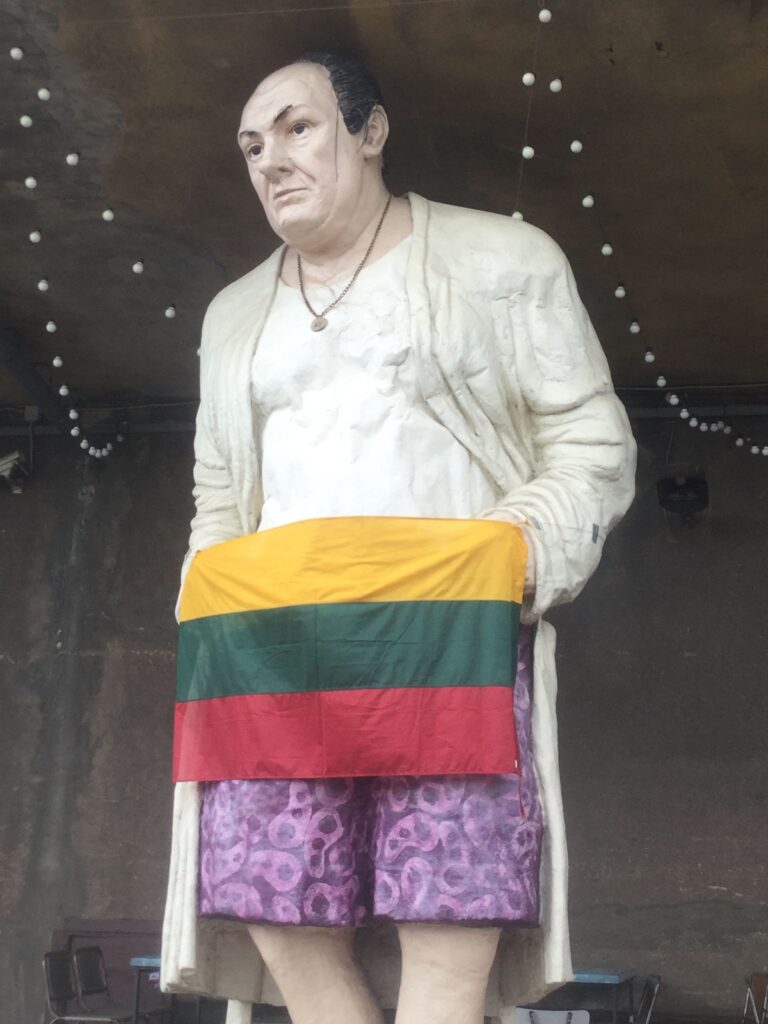
We walked around and saw some more street art, but since my guide seemed cool, I asked about the underworld of Vilnius. Much like Poland, he said there was a lot of teenage alcoholism. And he explained that is why they close down the alcohol section from Friday evening to Monday morning of every supermarket.
He also shared that alcohol was one of the ways that Soviet pensioners were able to supplement their income. Apparently, after distilling their own vodka, Lithuanian babushkas would carry buckets of the stuff with them to the local hang-out places and charge people to dip their cups in. Their trick was they would walk up to someone, place their bucket on the ground, tell them the price, lean in, and pinch their cheeks telling them they reminded them of their son/daughter and would drop the price to what they really wanted. It was a genius system.
We then made our way to a weird but endearing little neighborhood of Uzupis. And by neighborhood, I mean independent republic. Apparently, on April Fools Day in 1997, this area of Vilnius decided to become its own republic with a constitution, flag, president, and an army of 12. They even have a passport stamp! I realized this is something New Orleans would do. It was a beautiful little piece of land with a small river running through it and looked like the perfect place for an independent republic. I made sure to remember how to come back.
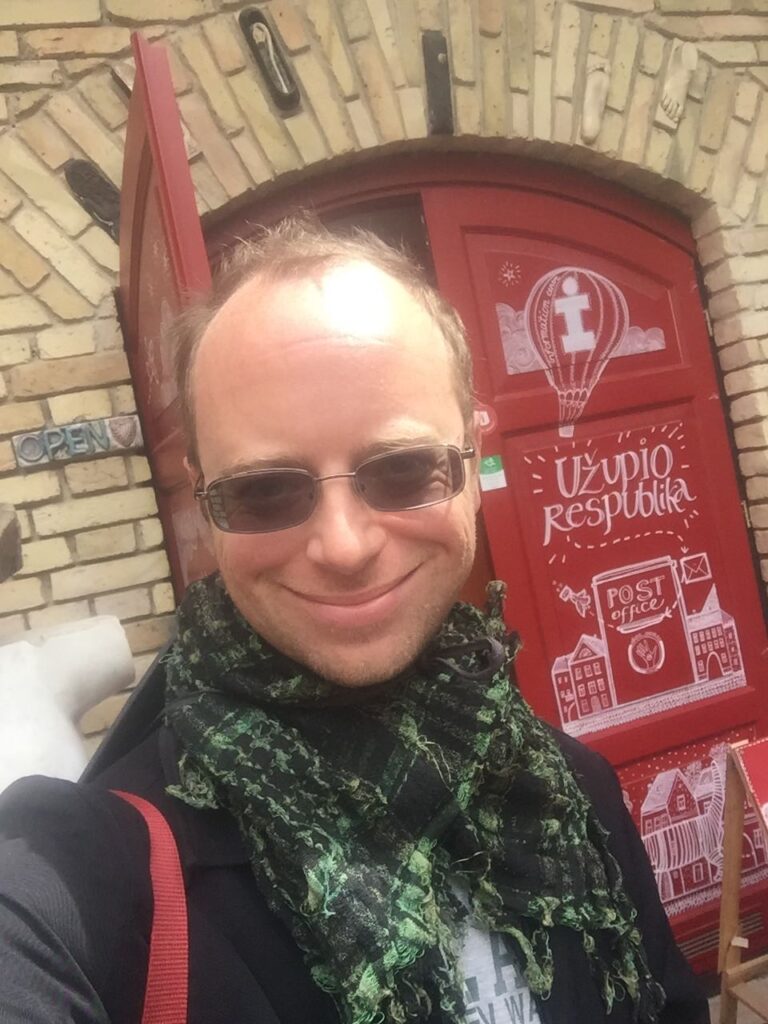
While it was a good tour, it was made even better as I made a friend. J was a very pretty German young lady that reminded me of one of my sister’s friends that everyone had a crush on in college. We decided to go grab a drink after the tour and ended up having dinner. We got to talking and I learned that she was from East Berlin, so of course, the conversation turned to her experiences growing up. She said that she was very young when the Wall came down, but that it took a long time for her parents to thaw from the Cold War. We then started comparing travel stories. Being in the EU and being German, she felt that in places like the Baltics, people gave her an icy reception. I told her that is what it was like being an American, everyone had a formed opinion about me and my country even though they had not met me or traveled there. Another thing I told her is that the media of a lot of countries focus on what is going on back in the States to deflect their own shortcomings. I also told her about my time in Serbia and that is the only point where I felt unsafe.

J and I walked around town some more, headed back to Uzupis to have some more beer, played her German dice game she carried with her, and I watched her add a few of her football club’s stickers to signs around town. I walked her back to her hostel and we made plans to take a bike ride the next day to what sounded like an interesting park.
I did not really sleep well due to all the drinking I did with J, but that was what Red Bulls were for. We met in the square next to the cathedral and the irradiated monument and headed to the bike shop. We rented our bikes, did a security check of the equipment that included a smack on J’s helmet that she did not appreciate, then headed out. It was 19km away which included getting out of the city. We passed some cool spots I wanted to check out later and then got on a country road. We followed a map, but unfortunately, when J talked me into it, she did not know how to read topography lines. She thought the ride would be flat like it was in Germany. Unfortunately, it was not. There were lots of big hills that were fun going down, but not up. Anyway, we continued on and finally got to Europas Parkas.

Europas Parkas is billed as the geographic center of Europe. It was less of a park and more of a sculpture garden but still very cool. There were a lot of interesting installations that were very spread out, but my favorite was a bunch of old TVs all stacked in the middle of the forest. There was also a pyramid in the middle of the park that marked the exact geographic center of Europe.

After the park, we decided to head back. Unfortunately, J could not handle all the uphill riding again and we decided to hop a bus to the city. The first bus would not let us on with our bikes. The second bus, J went up and somehow sweet-talked the driver into letting us on. So, I grabbed the bikes, entered the back door of the bus, and stood there as J came over. The bus started moving. About five stops away, some men in yellow vests with badges came on the bus and asked for our tickets. I looked at her expectantly. She just looked at me blankly. I realized that she just had us get on the bus and she did not buy tickets. One policeman came over to us and tapped J on the shoulder asking for her ticket in Lithuanian. He then tried English. She shook her head. They then looked at me and tried Lithuania, then English. I looked down at the floor as they asked for identification. Luckily, there were two scruffy-looking teenagers that were locals that did not have tickets, so the two police escorted them off the bus leaving J and I behind. The bus pulled away. As the distance increased, I just looked at her and said that was a close one. She said that she did not want to take out her passport because she did not know how they would act if they found out she was German. I did not ask her how did she think they were going to act if they found out we did not pay for tickets. Anyway, we miraculously made it to the end of the line which was just on the other side of the Vilnia River. We biked back to the shop and dropped off the bikes.
We decided to quench our thirst with some more beer in Uzipis so that J could also stamp her passport. After that, we got dinner at Etno Dvaras and talked. She said that the next day she was leaving to go to another part of Lithuania, but in a few days, she would be in Tallinn. I told her that the day after next that I would be heading to Riga then would also be in Tallinn. I said we should meet up there. She smiled and agreed. She gave me her email address as a way to stay in touch and also emailed me over photos of our day. She came back to my hostel and we finished up her dice game with a few more beers. I then walked her about halfway through Old Town where we said our goodbyes. She then kissed me. I did not know if this was a more European thing, but given what she said about her family not really showing affection, I figured this meant something. I told her I would see her in Estonia.
The next day, there were still some things I wanted to see around town. After breakfast, I headed over to the local mall. They advertised they had an Infinity Room and as I missed my chance in Tokyo, I really, really wanted to experience one. However, like any boy, before I got there, I had to stop and play at the arcade. One game caught my eye. It was a shooting game with six plastic guns all made to look like Romanian assault rifles with operating slides. It was a Chinese game designed for Russia but being played in Lithuania. Anyway, the setup was obviously war, but the disturbing part was that all the enemies looked like NATO troops. I placed second for the day which allowed me to take a selfie to show everyone my skills to be displayed on the big screen until my record was broken. Probably should have thought that one through a bit more.

Anyway, I continued on to the Infinity Room. An Infinity Room was first designed by the Japanese artist Yayoi Kusama using mirrors and LEDs to convey an endless space. The cost was a whopping 2€. Since the one I wanted to visit in Tokyo was over 20 times that price, I knew I had found a deal. It was amazing and a great experience. I got my obligatory selfies and continued on my way. Since it was raining, I walked around the mall a little bit. It was just like any mall except for the little differences. One of the interesting things I saw was a contact lens vending machine.

After the mall, I made my way over to the now-defunct Soviet-era Philharmonic Hall. It is a great structure that J and I passed the day before. It was covered with graffiti and seemed to be a popular spot for those that wanted to huff glue in peace. However, this must have been a magnificent building back when it was being used.
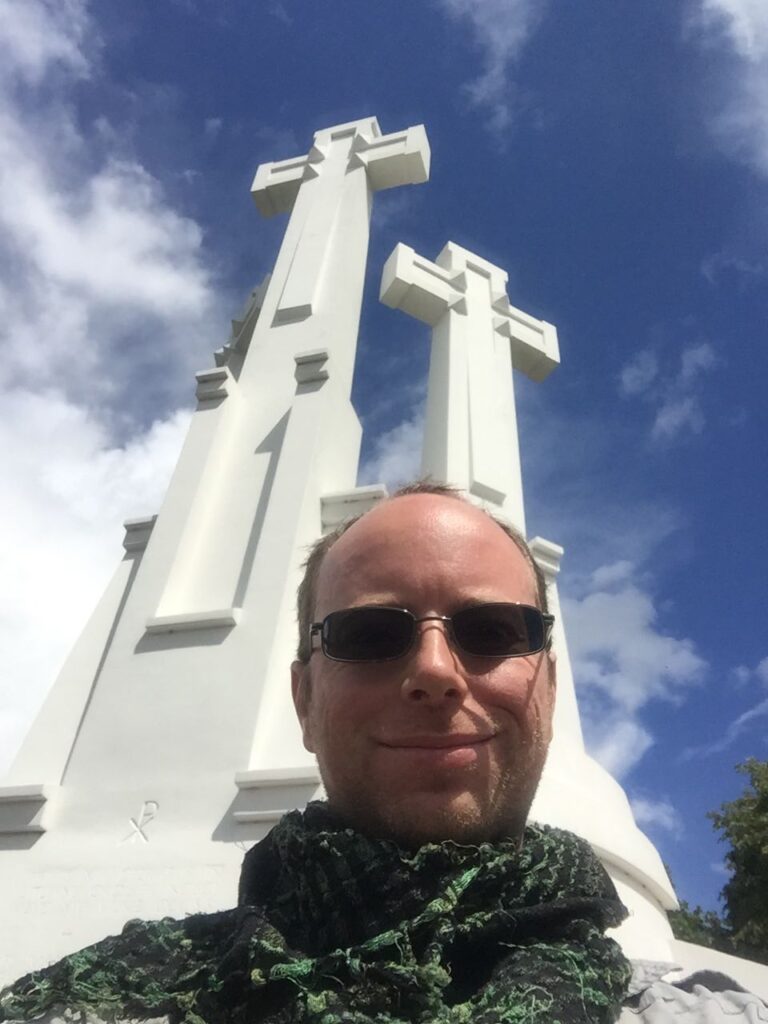
I then headed over to the Hill of Three Crosses that gave a sweeping, panoramic view of the city. It was quite a hike up through the woods of Vilnius, but very much worth it. I am glad I wasn’t murdered going through these woods as the trail was off the beaten path.
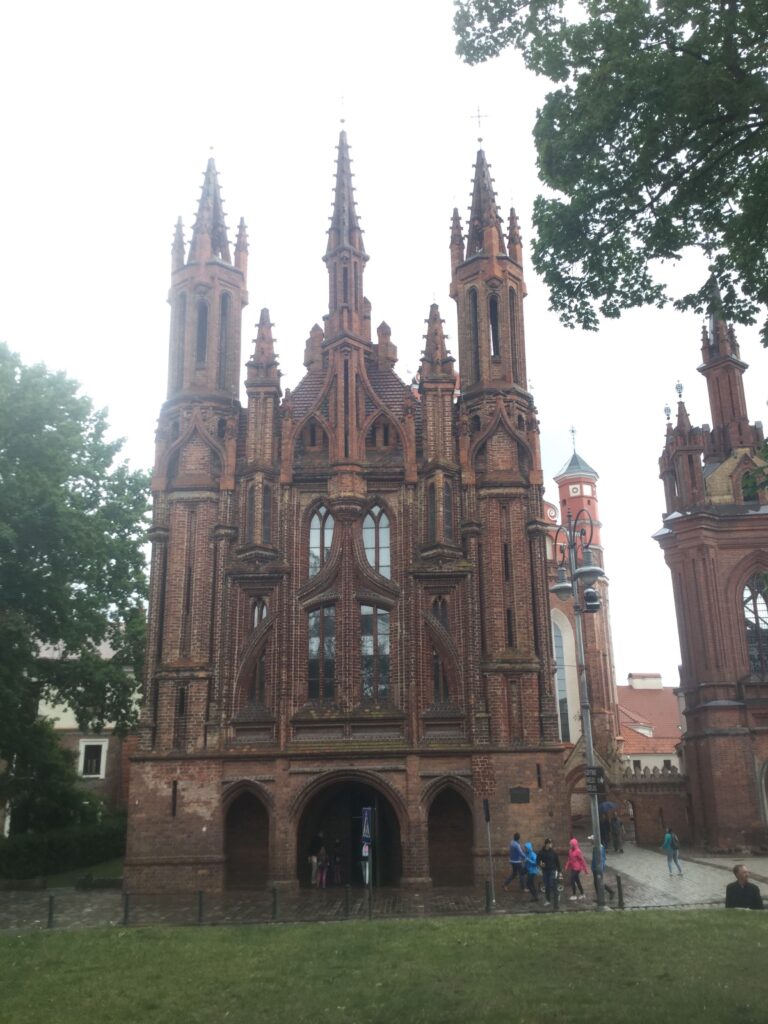
After, I walked over to a church where, apparently, Napoleon stabled his horses either on his way or coming back from his Eastern campaign. It was interesting because it was made of bright red bricks as most of the other churches I had seen were plaster or stone. I stayed in the church for a bit until the rain stopped again, then headed over to another restaurant that my friend’s article suggested one try. Unfortunately, it was hella expensive and closed, so I sauntered back to Etno Dvaras and got my lunch of lager beer, Cepilini, and for dessert, a tree cake. It was unreal.
After being caught in the rain for a bit, I could feel my throat getting a little sore, so I decided to make myself another hot toddy and relax. Josh, one of my Aussie roommates, invited me out for a drink with his girlfriend and our other roommate, so I joined them. We found a British pub that was only a block away from the hostel. It was cool because, in order to enter the bar, you needed to walk into an old-fashioned big red British phone booth. We sat down at a barrel, ordered some beers, and started talking. While I knew about Bree and Josh, our other roommate was from Sweden. Apparently, he was kick boarding from Sweden to Siberia, then trekking across Mongolia. He had been to India, Kashmir, and all around Asia and South America. Even though I would consider myself a bit of an adventure traveler, as he was relaying his stories, one of which had him drunkenly entering a muy thai fight in Phuket, Thailand which he won because the other guy was drunker, I said to myself this dude is fucking crazy; but in an endearing, optimistic way. We closed down the bar and we all decided to head back to the room and pass out after midnight.
